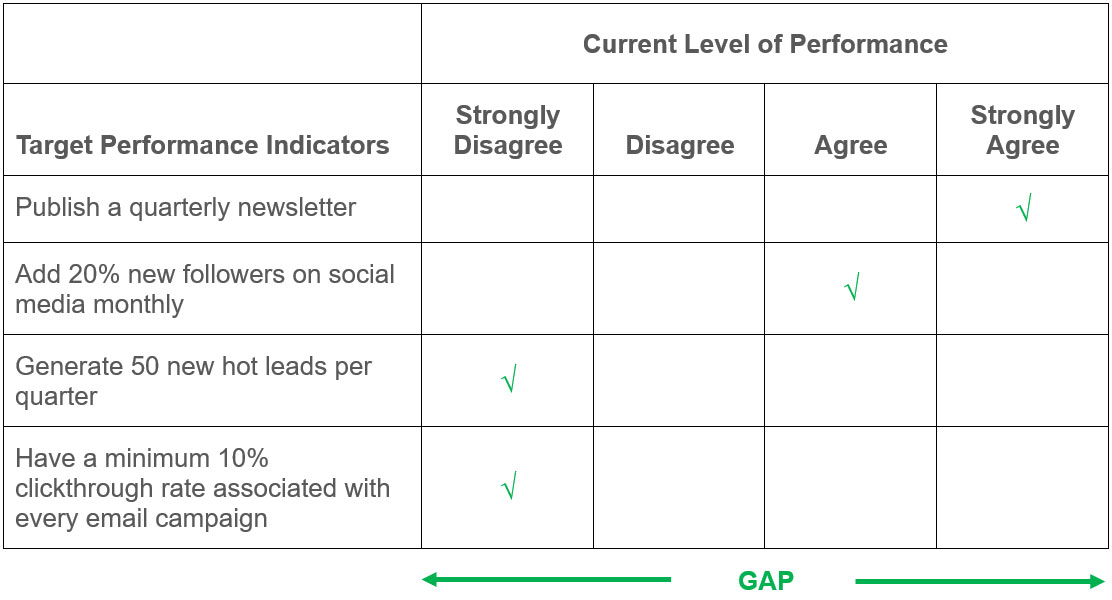What It Is and How To Do It
Gap Analysis is an effective, yet simple, method to help assess current performance and it can be invaluable in planning preparation. I noticed, however, when mentioning it, that many business executives were either not aware of it or had forgotten about it. I decided, therefore, to put together a quick reminder with practical steps to implement it.
Simply put, Gap Analysis is a technique to compare actual performance with a desired performance. That “desired performance” could be your own goals, certain optimal level, or best practice you strive to achieve. The “gap” refers to the difference between the desired performance and the actual performance, which might assist in determining where effort, corrective measures, and resources should be applied.

Gap Analysis can be conducted to assess any part of your business from overall execution and outcomes, to measuring the implementation and results of all facets of your business (such as finance, IT, operations, human resources, sales, marketing, and more).
This method is one additional tool your company may use to analyze current conditions in order to measure performance and plan for the future. I am not suggesting that Gap Analysis should be the only one you use, nor am I necessarily proposing that you forgo other analysis procedures like SWOT, etc.
What makes Gap Analysis an attractive tool and a very useful one to provide you another perspective of current conditions include:
- It clearly points out areas for improvement or change
- It is easy to conduct
- Results are very visual and, therefore, easily relatable by all stakeholders
Although there are several rather involved and somewhat complicated procedures to conduct Gap Analysis, I would like to offer a simple and straightforward approach. As we know, if the procedure is too involved or complicated, we are less likely to engage.
Since we focus on marketing, the examples below will feature marketing-related Gap Analysis – But remember: this can be applied to any discipline of your organization, as well as the organization’s performance overall.
How to conduct a Gap Analysis:
- Establish Target Performance Indicators:
The Target Performance Indicators are statements of the conditions you wish to achieve. Remember, these indicators might be your own goals, optimal levels, as well as best practices. Here are a few examples of marketing-related Target Performance Indicators:
- Publish a quarterly newsletter
- Add 20% new followers on social media monthly
- Generate 50 new hot leads per quarter
- Have a minimum 10% clickthrough rate associated with every email campaign
- Assess Current Level of Performance:
Using the best available data and other impressions, indicate your current level of performance relative to the Target Performance Indicators. You and your team must be very honest with yourselves in assessing your performance, otherwise this exercise would be worthless.
Here is how it is done:
Using the same Target Performance Indicators example above, let’s assume that you did publish a quarterly newsletter every month, you were able to add 20% new followers on social media some months but not all months, you were unable to generate 50 hot leads each month, and you did not achieve 10% clickthrough rate with the majority of your email campaigns – Your Gap Analysis table will look like this:

- Analyze and Plan Accordingly:
Clearly, the biggest gaps in the example above are in two areas: (1) lead generation and (2) achieving the desired clickthrough rate. In addition, there is a moderate gap in acquiring additional social media followers.
Now, you have to decide whether your Target Performance Indicators were too lofty and therefore should be adjusted; or perhaps not, and improvements are needed to achieve them. This might require allocating additional resources (people, time, or money) to the problem area, taking a different approach, or something else. Whatever your decision might be, the value of the Gap Analysis is its ability to highlight challenges relatively easily in a clear and concise manner.
As mentioned previously, the examples above were just that – Examples. You and your team should come up with the Target Performance Indicators that make the most sense for your operation, based on your circumstances.
Lastly, there are software tools (including online ones) that make the process, scoring, and assessment easy and smooth. If you need help constructing your Gap Analysis and conducting it (3rd party facilitators tend to result in more objective avaluations), we will be happy to help.

Duke Merhavy, MBA, Ph.D.
President & Chief Marketing Officer

